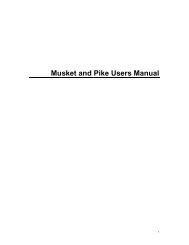Designer's note - Scenario Design Center
Designer's note - Scenario Design Center
Designer's note - Scenario Design Center
Create successful ePaper yourself
Turn your PDF publications into a flip-book with our unique Google optimized e-Paper software.
At beginning of the Fulda Gap ‘85 project, we considered how a "hot war "could be<br />
portrayed. The seminal idea came to us as we looked at the garrison map of East and<br />
West. What would happen if the Warsaw Pact executed a surprise attack? Would that<br />
have been at all possible without the NATO having been aware of preparations? How<br />
much time would it have taken for the Warsaw Pact to move divisions to the<br />
German-German border?<br />
The last question can be answered: it would have taken 6-9 hours to march the first wave<br />
of divisions from their garrison positions to the border, at least in theory.<br />
We assume in this scenario that the surprise would be more or been less perfect. What<br />
would the Warsaw Pact have found in West Germany? NATO units that were in their<br />
barracks, an intact road system and, importantly, a population who is also surprised<br />
completely. This all together would have brought the Warsaw Pact an immense<br />
advantage and fast progress in the direction of the Rhine without major resistance in the<br />
first days.<br />
Warsaw Pact strategy<br />
The Warsaw Pact Player should try to possibly cross West-Germany as fast as possible,<br />
avoiding major skirmishes close to the German-German border. Speed is all important<br />
here so as to succeed before NATO re-groups and builds an effective defence line. With<br />
some luck and skill, the Warsaw Pact can push forward units until near Frankfurt without<br />
meeting with an interrelated front line. The big advantage of the Warsaw Pact is its<br />
enormous number of soldiers and vehicles. Later arriving divisions should be used to<br />
mop up smaller NATO forces while preparing to storm Frankfurt with the initial divisions.<br />
However, the player also must be careful not to exhaust entire divisions, since the quality<br />
of the troops is considerably worse then NATO’s. Therefore, front divisions should be<br />
rested from time to time.<br />
NATO strategy<br />
Generally, the player should play the NATO side. The player has two options: to<br />
immediately offer the Warsaw Pact local resistance or, to immediately fall back, form an<br />
adequate defensive line and to wait for reinforcements from the south. The second option<br />
is recommended, since the Warsaw Pact's "steam roller" is not to be underestimated in<br />
the first days of the conflict. Nevertheless, if the player has the chance to resist with bigger<br />
units, he should, while avoiding a major defeat. When the reinforcements arrive, the<br />
player should be capable of starting a successful counteroffensive and to advance as far<br />
as possible towards the East German area conceivably.<br />
IVb. Classic Variant<br />
This scenario treats the more or less "classic" concept of an East-West conflict. There is<br />
already innumerable literature and games dealing with this conflict.<br />
Both sides are prepared for the forthcoming war and the Warsaw Pact crosses the<br />
border.<br />
Warsaw Pact strategy<br />
The player should from the start to try to find gaps in the NATO defence and to break<br />
Page 12




